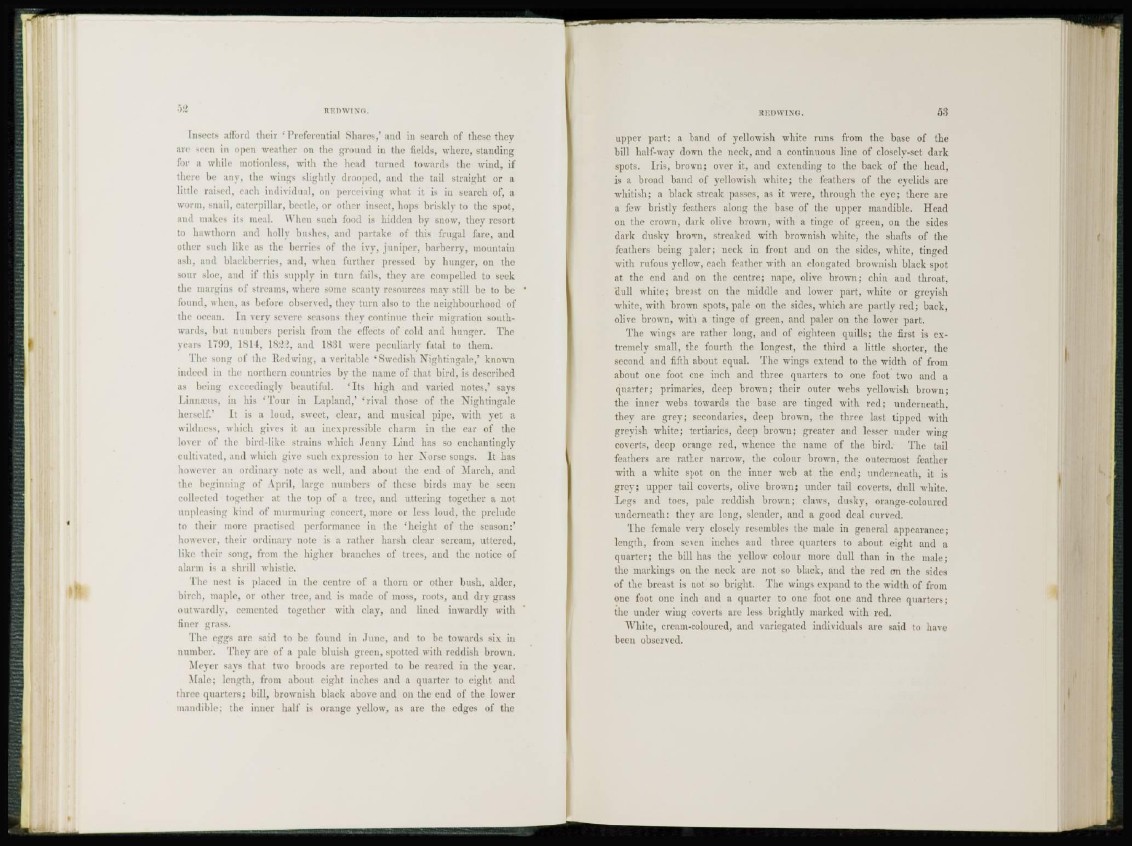
REDWING.
Insects- afford their 'Preferential Shares,'and in search of these they
are seen in open weather on the ground in the fields, where, standing
for a while motionless, with the head turned towards the wind, if
there be any. the wings slightly drooped, and the tail straight or a
little raised, each individual, on perceiving what, it is in search of, a
worm, snail, caterpillar, beetle, or other insect, hops briskly to the spot,
and makes its meal. When such food is hidden by snow, they resort
to hawthorn and holly bodies, and partake of this frugal fare, and
other such like as the berries of the ivy, juniper, barberry, mountain
ash, and blackberries, and, when further pressed by hunger, on the
sour sloe, and if this supply in turn tails, they are compelled to seek
the margins of streams, where some scanty resources may still be to be
found, when, as before observed, they turn also to the neighbourhood of
the ocean. In very severe seasons they continue their migration southwards,
hut numbers perish from the effects of cold and hunger. The
years 1799, 1814, 1S:>>, and 1831 were peculiarly fatal to them.
The song of the Redwing, a veritable 'Swedish Nightingale,' known
indeed in the northern countries by the name of that bird, is described
as being exceedingly beautiful. ' Its high and varied notes,' says
1 n n t n e u s . in his 'Tour in Lapland,' 'rival those of the Nightingale
herself.' It is a loud, sweet, clear, and musical pipe, with yet a
wildness, which gives it an inexpressible charm in the ear of the
lover of the bird-like strains which Jenny Lind has so enchantingly
cultivated, and which give such expression to her Xorsc songs. It has
however an ordinary note as well, and about the end of March, and
(he beginning of April, large numbers of these birds may be seen
collected together at the top of a tree, and uttering together a not
unpleasing kind of murmuring concert, more or less loud, the prelude
to their more practised performance in the 'height of the season:'
however, their ordinary note is a rather harsh clear scream, uttered,
like then* song, from the higher branches of trees, and the notice of
alarm is a shrill whistle.
'['he nest is placed in the centre of a thorn or other bush, alder,
birch, maple, or other tree, and is made of moss, roots, and dry grass
outwardly, cemented together with clay, and lined inwardly with
finer grass.
The eggs are --aid to be found in June, and to be towards six in
number. They are of a pale bluish green, spotted with reddish brown.
Meyer -•ays that two broods are reported to he reared in the year.
Male; length, from about eight inches and a quarter to eight and
three quarters; bill, brownish black above and on the end of the lower
mandible; the inner half is orange yellow, as are the edges of the
REDWING. 58
upper part: a band of yellowish white runs from the base of the
bill half-way down the neck, and a continuous line of closely-set dark
spots. Iris, brown; over it, and extending to the back of the head,
is a broad band of yellowish, white; the feathers of the eyelids arc
whitish; a black streak passes, as it were, through the eye; there are
a few bristly feathers along the base of the upper mandible. Head
on the crown, dark olive brown, with a tinge of green, on the sides
dark dusky brown, streaked with brownish white, the shafts of the
feathers being paler; neck in front and on the sides, white, tinged
with rufous yellow, each feather with an elongated brownish black spot
at the end and on the centre; nape, olive brown; chin and throat,
dull white; breast on the middle and lower part, white or greyish
white, with brown spots, pale on the sides, which are partly red; back,
olive brown, with a tinge of green, and paler on the lower part.
The wings arc rather long, and of eighteen quills; the first is extremely
small, the fourth the longest, the third a little shorter, the
second and fifth about equal. The wings extend to the width of from
about one foot one inch and three quarters to one foot two and a
quarter; primaries, deep brown; their outer webs yellowish brown;
the inner webs towards the base are tinged with red; underneath,
they are grey; secondaries, deep brown, the three last tipped with
greyish white; tcrtiaries, deep brown; greater and lesser under wing
coverts, deep orange red, whence the name of the bird. The tail
feathers are rather narrow, the colour brown, the outermost feather
with a white spot on the inner web at the end; underneath, it is
grey; upper tail coverts, olive brown; under tail coverts, dull white.
Legs and toes, pale reddish brown; claws, dusky, orange-coloured
underneath: they are long, slender, and a good deal curved.
I h e female very closely resembles the male in general appearance;
length, from seven inches and three quarters to about eight and a
quarter; the bill has the yellow colour more dull than in the male;
the markings on the neck are not so black, and the red mi the sides
of the breast is not so bright. The wings expand to the width of from
one foot one inch and a quarter to one foot one and three quarters;
the under wing coverts arc less brightly marked with red.
White, cream-coloured, and variegated individuals are said to have
been observed.